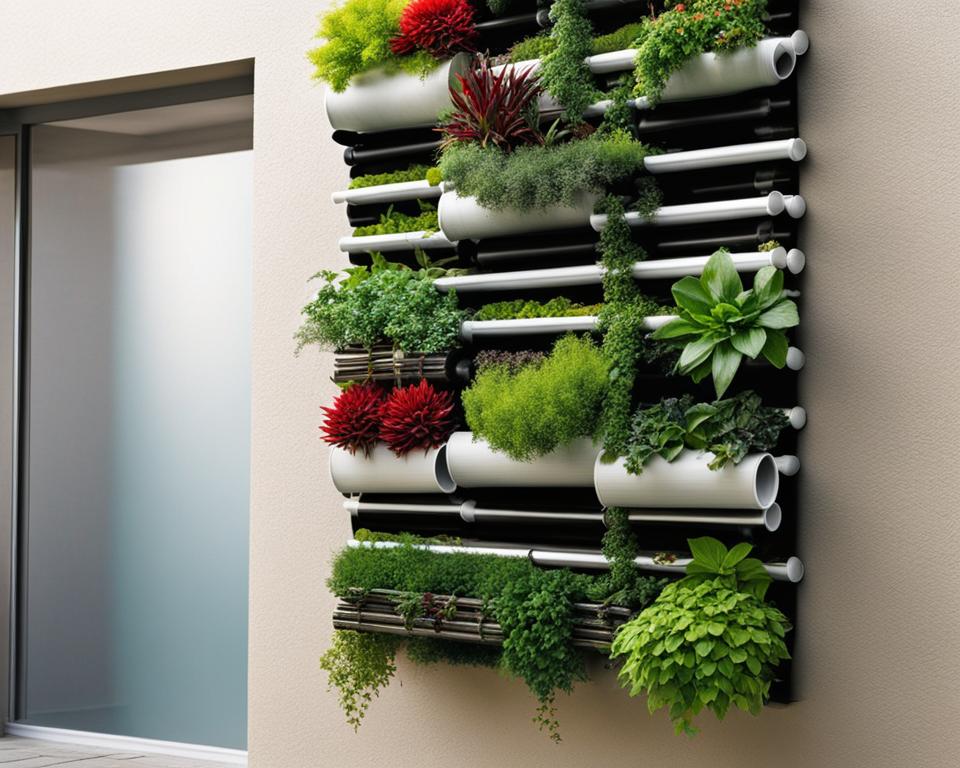When your ground space is limited, but your passion for gardening knows no bounds, vertical gardening with PVC pipe becomes your go-to solution. This innovative approach to gardening allows you to grow upwards, turning walls and even the smallest of patios into lush, edible gardens. Embrace the potential of DIY vertical gardening with PVC pipe, a method that empowers you to maximize space efficiently while indulging in the joys of cultivating your own plants. Discover the different vertical gardening methods that can escalate your home gardening to new heights, quite literally.
Key Takeaways
- Learn how vertical gardening can dramatically increase your planting space.
- Explore the versatility and ease of using PVC pipes to construct your vertical garden.
- Gain insight into the multiple benefits, including space efficiency and aesthetic appeal, of growing your garden vertically.
- Discover innovative DIY techniques to start your own vertical garden using readily available PVC pipes.
- Understand the ecological impact of vertical gardening and its contribution to sustainable living practices.
An Innovative Approach to Urban Agriculture
Urban centers around the world are constantly evolving, seeking sustainable ways to support growing populations. One cutting-edge example that stands out is Nature Urbaine in Paris, a pioneer in urban agriculture that harnesses the innovative use of vertical gardens using PVC pipe.
The Birth of Nature Urbaine in Paris
Hovering above the hustle and bustle of city life, Nature Urbaine marks a revolution in urban farming within the historic city of Paris. This project is more than just a demonstration of agricultural innovation; it’s a rooftop utopia at the Versailles Exhibition Park showcasing a harmonious blend of nature and urban infrastructure. By integrating PVC pipes and bamboo into its design, Nature Urbaine crafts a robust structure light enough for rooftop sustainability, proving its effectiveness in sustainable food production.
Benefits of Vertical Gardening in Urban Environments
Vertical gardens using PVC pipes offer myriads of advantages in cities like Paris. Not only do they optimize limited urban spaces, providing fresh and local produce, but they also mitigate the environmental impact associated with traditional agriculture. Imagine your grocery comes from just above your head rather than hundred miles away, drastically reducing the carbon footprint from transportation.
Sustainable Development Goals and Urban Farming
The initiative of Nature Urbaine is not just about aesthetic appeal or novelty; it’s a practical response to achieving the Sustainable Development Goals. Its commitment to utilizing a vertical garden using PVC pipe as a cornerstone for urban agriculture directly caters to ending hunger (SDG2) and advancing sustainable cities and communities (SDG11). By making food locally available, Nature Urbaine is a beacon of change, guiding Paris towards a greener, self-sufficient future.
| SDG Objective | Contribution of Vertical Gardens | Impact on Paris Urban Environment |
|---|---|---|
| SDG2: Zero Hunger | Providing fresh, local produce | Reduces reliance on imported goods |
| SDG11: Sustainable Cities and Communities | Enhancing green spaces, reducing emissions | Creates a healthier, more sustainable urban life |
By considering Nature Urbaine as a framework, your venture into urban agriculture can reflect Paris’s commitment to integrating green solutions in cityscapes. Embracing the wisdom Nature Urbaine imparts, you’ll not only be pushing the envelope in urban farming but also contributing to a collective vision of a more sustainable, food-secure world.
Vertical Gardening with PVC Pipe: Durable, Safe, and Recyclable
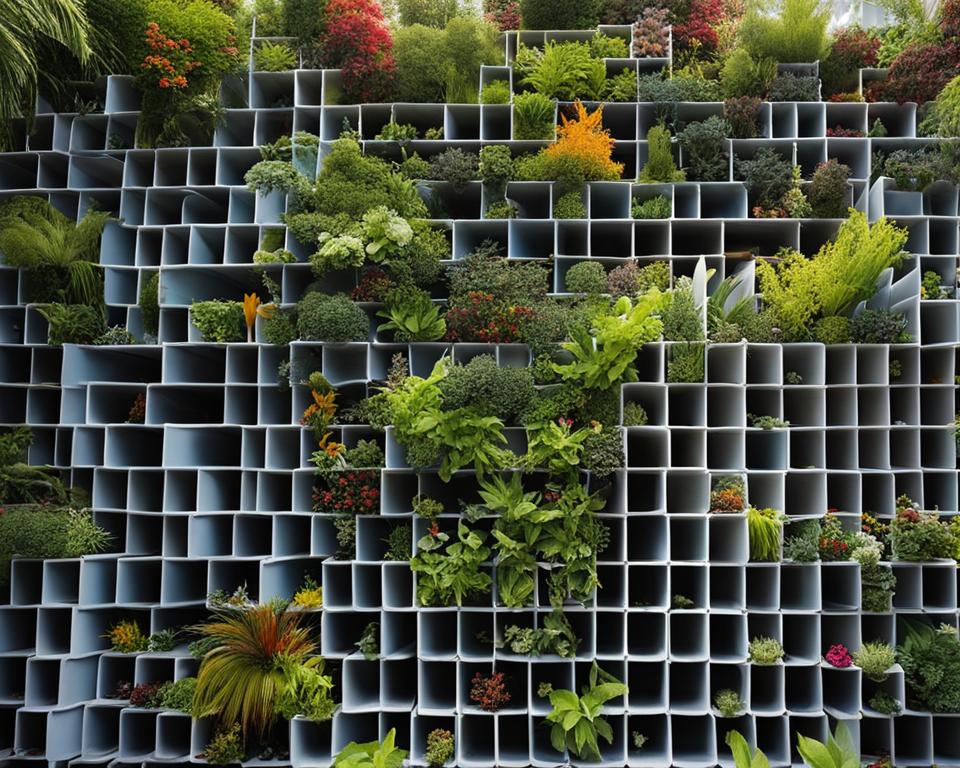
Embracing the concept of pvc pipe vertical gardening is not just a trend; it’s a sustainable practice that can revolutionize the way you cultivate your garden, utilizing minimal space for maximum yield. The robust properties of PVC have made it a cornerstone in the development of vertical gardening systems with pvc pipe, combining efficiency with eco-friendliness. Whether you’re a do-it-yourself enthusiast or a professional looking to integrate greener practices into urban agriculture, understanding the benefits of PVC for vertical gardening is critical to your success.
PVC’s intrinsic durability and light weight make it ideal for constructing durable frameworks that withstand the elements while being easy to maneuver and install. As you delve into DIY projects or large-scale urban gardens, safety is paramount. Thankfully, PVC is known for being a safe material that doesn’t easily break or corrode, ensuring that your plants have a secure environment to thrive in. Moreover, the fact that PVC is recyclable resonates with a global push towards sustainable living and cost-effective gardening solutions.
Inspiration for your vertical gardening endeavours can be found in compelling initiatives such as the VinylPlus-supported Garden to Connect in Aarhus, Denmark. This project boldly demonstrates the value of reusing PVC by transforming previously discarded materials into flourishing vertical gardens. These gardens don’t just beautify urban spaces; they also serve as pivotal resources for local food production, aligning with contemporary narratives of sustainability and social responsibility.
- Durability: Able to bear the load of soil and water with minimal risk of damage.
- Safety: Non-toxic and stable material that ensures a safe growth environment.
- Recyclability: PVC can be repurposed, reducing waste and making vertical gardening an eco-friendly venture.
Join the movement of sustainable gardeners and tap into the benefits of using PVC pipe in your vertical garden. Witness the transformation of your gardening space into a lush, productive, and eco-conscious oasis.
Designing a Vertical Garden: Creative Ideas and Tips
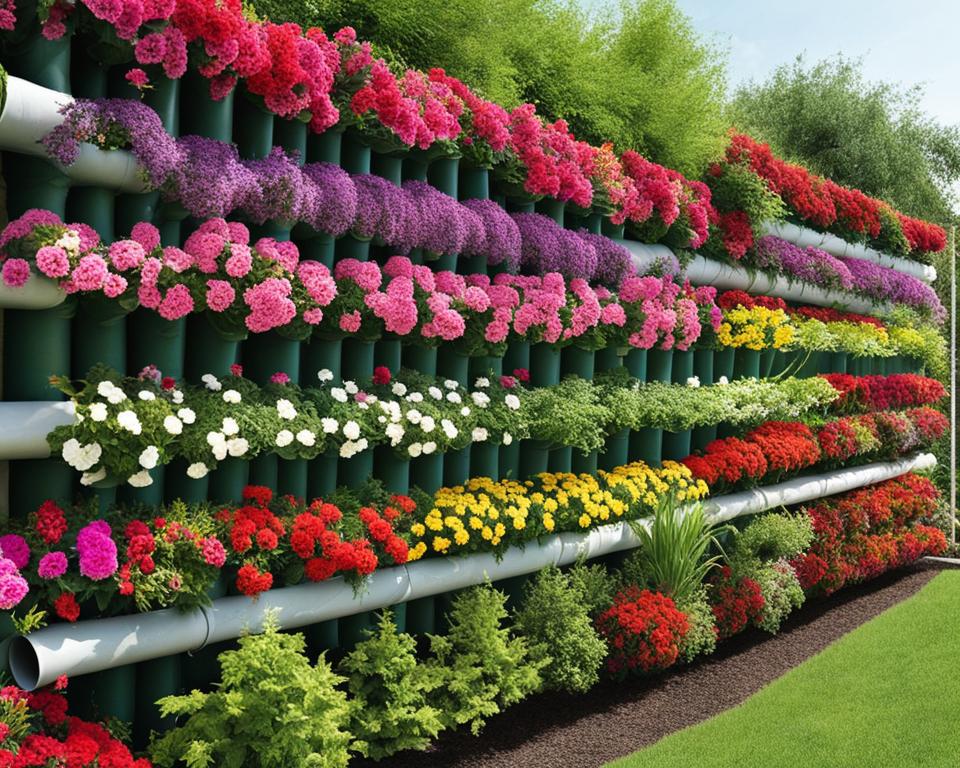
Embarking on the journey of creating a vertical garden requires careful consideration of your available resources and your plant’s needs. With vertical gardening ideas using PVC pipe, your green space can evolve into a thriving and efficient oasis in the middle of a bustling city or a cozy corner of your backyard.
Planning for Sunlight and Plant Requirements
Every plant species in your garden has unique sunlight and shade requirements. By planning sunlight exposure for your vertical garden, you ensure the lush growth of your plants. Consider the orientation of your garden and the movement of the sun across your space to optimize each plant’s light intake.
Selecting the Right PVC Pipe Dimensions for Your Garden
When contemplating selecting PVC dimensions, consider the diversity of plant sizes and root depths. Smaller plants with shallow root systems will thrive in narrower pipes, whereas larger, more robust plants will require broader dimensions for adequate growth.
Incorporating Drip Irrigation Systems for Water Efficiency
Water efficiency is paramount in the design of a vertical garden. Drip irrigation systems can be integrated into PVC piping, providing targeted hydration to plants. This setup not only conserves water but also delivers it directly to the roots, thus promoting healthier plants with less water waste.
| Plant Type | Pipe Diameter | Sunlight | Water Needs |
|---|---|---|---|
| Herbs (e.g., Basil, Mint) | 4-inch | Full Sun | Medium |
| Leafy Greens (e.g., Lettuce, Spinach) | 4-5 inch | Partial Shade | High |
| Small Fruiting Plants (e.g., Strawberries) | 5-inch | Full Sun | High |
| Flower Varieties (e.g., Marigolds) | Four-inch | Full Sun to Partial Shade | Medium |
Choose a vertical gardening idea with PVC pipe that aligns seamlessly with your gardening goals. Whether you are a seasoned gardener or a beginner, careful planning and the right equipment will pave the way for a vertical garden that not only looks beautiful but is also sustainable and fruitful.
Diy Vertical Gardening with PVC Pipe: A Step-by-Step Guide
If you’ve ever wanted to build a vertical planter and maximize your growing space, diy vertical gardening with PVC pipe is an excellent DIY project for you. This step-by-step guide will help you understand how to build a vertical planter that’s both functional and aesthetically pleasing, just perfect for urban gardeners or anyone looking to add a green touch to their space.
- Select the PVC Pipe: Choose a pipe with the length and diameter suitable for the type of plants you want to grow. A diameter of 4-6 inches is ideal for a variety of plants.
- Prepare the Base: Stability is key, so make sure you have a base that can support your vertical structure, whether it’s against a wall or freestanding.
- Drill Planting Holes: Space out and drill holes along the length of the pipe for your plants. Smooth the edges for plant safety.
- Set Up Drip Irrigation: For efficient watering, run a drip irrigation line inside the PVC pipe, wrapped in weed control fabric to prevent soil from clogging.
- Secure the Structure: Attach your PVC pipe securely to the base to ensure it doesn’t topple over when filled with plants and soil.
- Fill with Soil and Plant: Add potting compost into your pipe and carefully insert your chosen plants into the holes you’ve created.
- Finish with Gravel and Mulch: Top with gravel for stability and mulch for moisture retention, giving your plants a healthy environment to thrive in.
There you have it, a fully functional vertical garden ideal for small patios, balconies, or any place where ground space is a premium. Follow this step-by-step guide and enjoy the process of crafting your very own diy vertical gardening with PVC pipe. Happy planting!
Choosing Plants for Your Vertical Garden: Lettuce, Herbs, and More
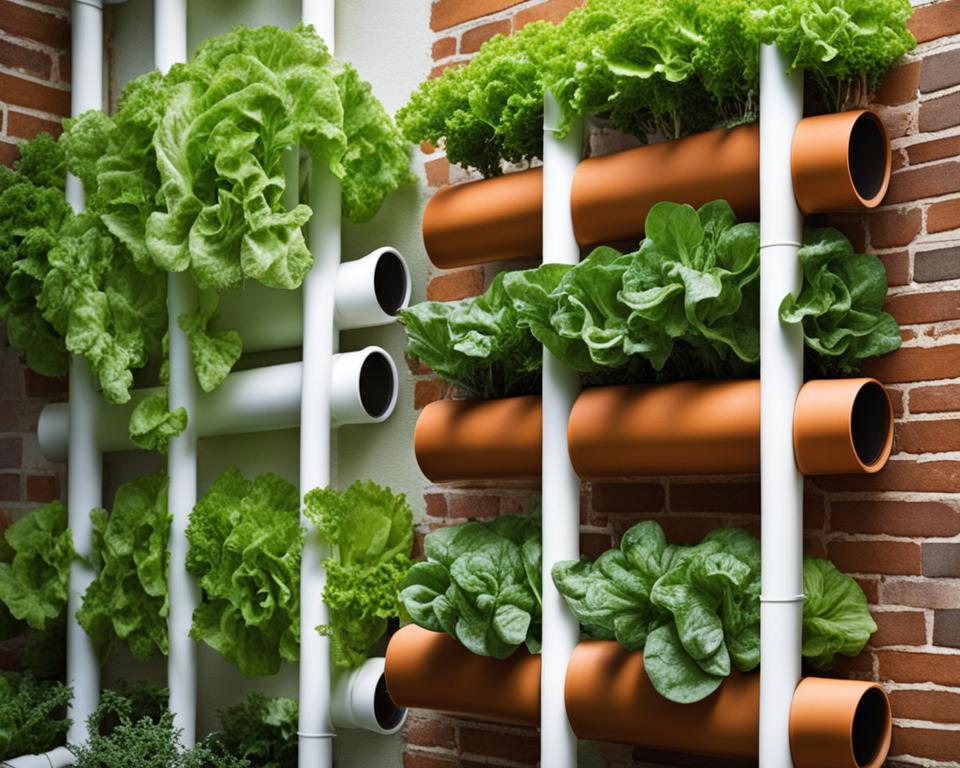
Embarking on vertical vegetable gardening with PVC pipe invites the thrilling challenge of selecting the right plants that not only flourish in confined spaces but also meet your light and nutrient needs. Whether you’re looking to enhance your culinary arsenal with fresh flavors or simply aiming to green your urban environment, recognizing the best vegetables and herbs pivotal for vertical growth will lead to a lush and prosperous garden.
Best Vegetables and Herbs for Vertical Gardening
When curating the perfect mix of flora for your vertical haven, start with considering leafy greens like lettuce, known for its compact nature, which integrates seamlessly into the vertical layout. Compact herbs such as basil, chives, and parsley also rise to the occasion, thriving in the lofty confines of a well-structured PVC garden. With a focus on height, root depth, and overall plant health, you can cultivate a vibrant tapestry of edible greens.
Considering Light and Nutrient Needs
Each plant species you include in your vertical garden comes with its unique requirements for sunlight and nourishment—a delicate balance that is essential for success. Assessing the site of your vertical installation and aligning your plant choices with its specific conditions ensures that your greens get the optimal amount of love from the sun and the rich nutrients they need.
Seasonal Planting Strategies
Employing seasonal planting techniques permits you to rotate crops, taking advantage of varying climactic conditions to maximize yield and diversity. It’s a strategic approach that not only enhances the productivity of your vertical garden but also contributes to the biodiversity that’s key to a healthy, resilient ecosystem.
| Vegetable/Herb | Light Requirements | Season | Comments |
|---|---|---|---|
| Lettuce | Partial to Full Sunlight | Spring/Fall | Great for cooler, transitional weather. |
| Basil | Full Sun | Summer | Thrives in warmth; prune regularly. |
| Chives | Full Sun to Partial Shade | Spring | Perennial; can grow back every year. |
| Parsley | Full Sun to Partial Shade | Spring/Fall | Biennial; can grow all season long. |
| Bok Choy | Partial Sunlight | Spring/Fall | Prefers cooler temperatures. |
By carefully selecting the right plants and tending to their individual needs, your vertical garden will not only become a source of fresh produce but also a vertical canvas reflecting your commitment to sustainable living and urban gardening excellence.
Vertical Gardening Tips with PVC Pipe: Maintenance and Care
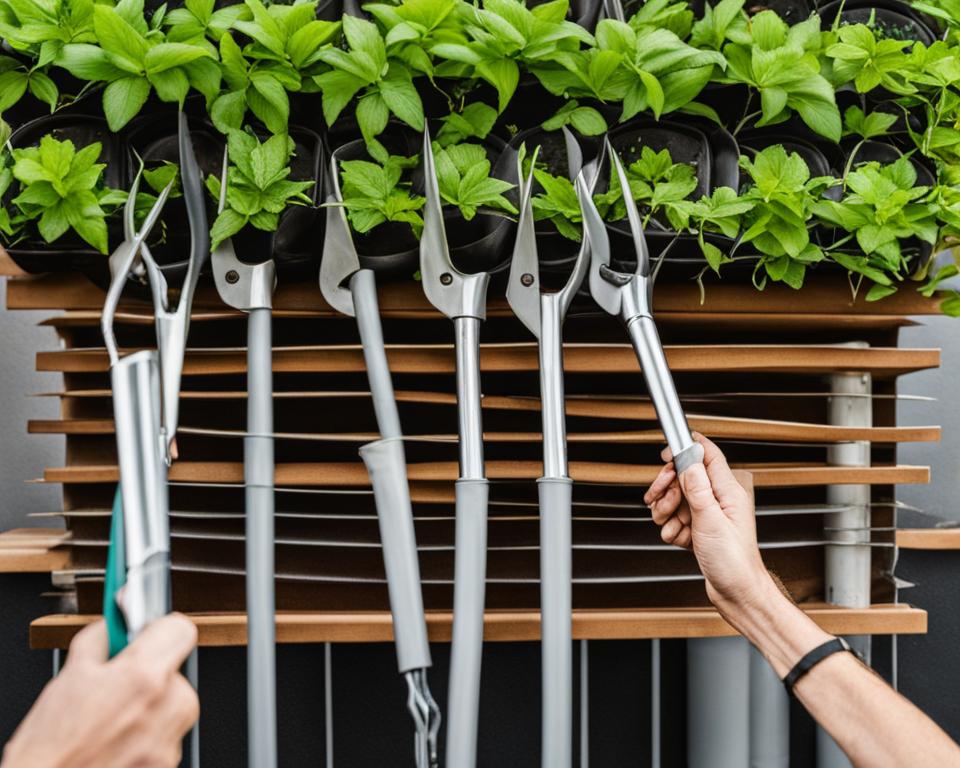
As you delve into the world of vertical gardening with PVC pipe, understanding the nuances of garden maintenance and plant care is crucial for the ongoing success of your verdant creation. Regular monitoring and proactive steps will ensure that your vertical oasis not only survives but thrives.
- Check the Irrigation System: A consistent flow of water is vital for plant growth. Adjust your drip irrigation to accommodate seasonal changes in weather, ensuring plants remain hydrated without causing waterlogging.
- Maintain Structural Integrity: Periodically inspect your PVC pipe structure for any signs of wear or damage, keeping it securely fastened in its vertical position for optimal plant support.
- Soil and Nutrient Management: Refresh your soil periodically with compost or fertilizers to replenish nutrients that are vital for robust plant growth.
- Pest and Disease Control: Keep an eye out for common garden pests and diseases. Early detection and treatment can save your vertical garden from potential outbreaks.
- Pruning and Deadheading: Regularly remove dead or yellowing leaves to encourage new growth and maintain the aesthetic appeal of your garden.
Below is a detailed seasonal garden maintenance schedule to guide you through the year.
| Season | Maintenance Activities | Plant Care Focus |
|---|---|---|
| Spring | Replenish soil, Start seedlings, Inspect irrigation | Prune winter damage, Begin fertilizing |
| Summer | Monitor watering, Manage pest activity | Maintain growth, Remove spent blooms |
| Fall | Prepare for cooler weather, Harvest crops | Reduce feeding, Plant cool-season crops |
| Winter | Protect from frost, Plan for next season | Care for overwintering plants, Prune dormant plants |
Embrace these vertical gardening tips with PVC pipe to simplify your garden maintenance routines and promote healthy, lasting growth in your vertical landscape. With these tips, your commitment to plant care will be rewarded with a lush, productive, and visually stunning vertical garden.
How Vertical Gardening Systems with PVC Pipe Contribute to a Greener Planet
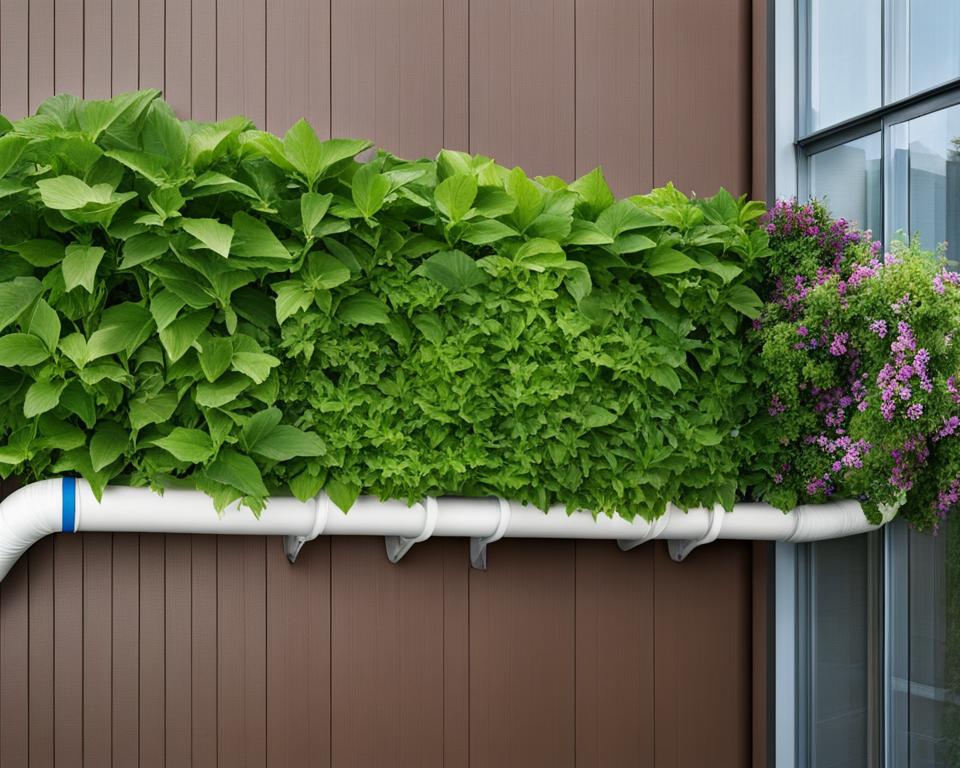
In an era where sustainability and environmental preservation are more important than ever, vertical gardening systems with PVC pipe are taking center stage. These innovative systems are much more than a trend; they represent a transformation in how we approach agriculture and urban development. Let’s delve into the aspects of how these systems are etching a greener future for our planet.
Reducing the Carbon Footprint with Localized Food Production
One of the fundamental benefits of utilizing vertical gardening systems derives from their ability to foster localized food production. By growing closer to where the produce is consumed, you not only reap the benefits of fresher goods but also significantly reduce the carbon footprint of your food. This reduction is due to the minimized need for transportation over long distances, which is a major contributor to greenhouse gas emissions.
Water Conservation through Innovative Gardening Practices
Water is a precious resource, and vertical gardens utilizing PVC pipes have shown that water conservation can be seamlessly integrated into urban farming. The strategic use of drip and aeroponic irrigation systems allows for optimal water usage, delivering water directly to the roots of the plants and reducing evaporative loss. This method not only conserves water but also promotes healthier plant growth by preventing overwatering and soil erosion.
Recycling and Upcycling: The Role of PVC in Sustainable Gardening
PVC’s role in sustainable vertical gardening systems is multifaceted. This lightweight, durable material can easily be recycling and upcycling, turning what would be waste into the foundations of prolific gardens. Urban agricultural projects often resort to reusing PVC pipes, thus upholding the principles of sustainable gardening and contributing to the creation of greener urban spaces.
| Efficiency Feature | Benefit | PVC Contribution |
|---|---|---|
| Localized Production | Reduces transportation emissions | Structural support for vertical spaces |
| Water Conservation | Minimizes water waste | Integrated drip systems in PVC |
| Recycling/Upcycling | Lowers waste and promotes sustainability | Reused materials for new garden projects |
DIY PVC Pipe Trellis for Vertical Gardening: Practical and Functional
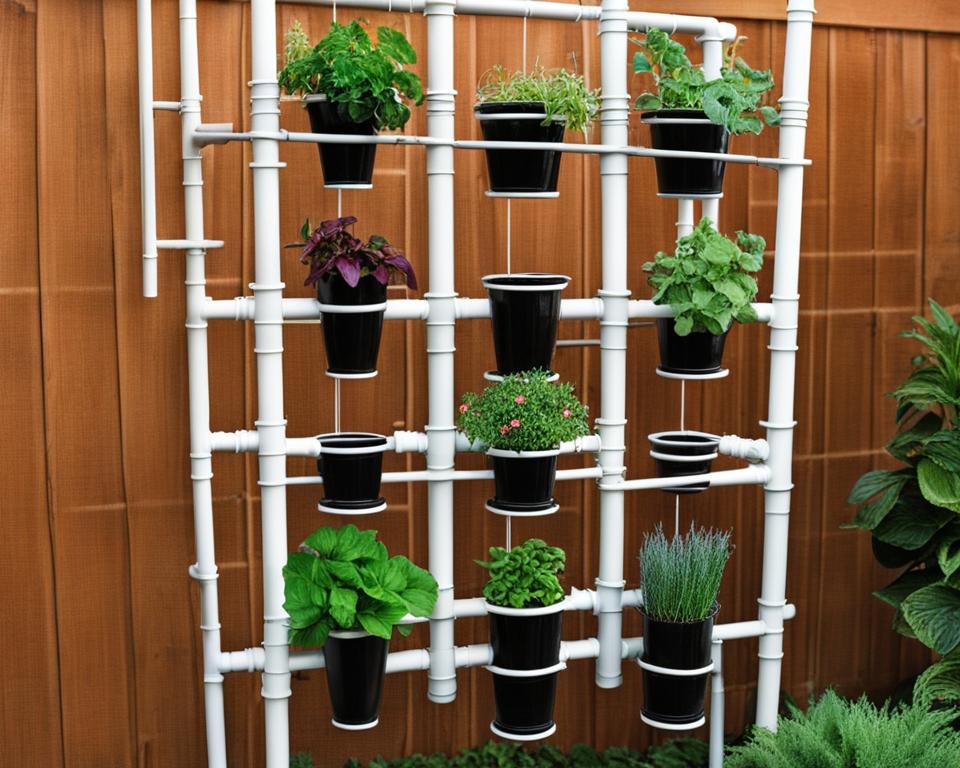
Embarking on a DIY PVC trellis project? You’re about to enhance your garden’s productivity and visual appeal. Crafting a pvc pipe trellis for vertical gardening doesn’t just save space, it also brings a new level of organization and ease to your gardening efforts. Whether you have a spacious backyard or a cozy balcony, vertical gardening using PVC pipe trellises opens up a world of possibilities for growing everything from lush vines to substantial vegetables.
These trellises are not only pocket-friendly but also incredibly durable, able to withstand different weather conditions without succumbing to rust or rot. A practical functional garden is within reach as you tailor your DIY PVC trellis to your spatial needs and aesthetic preferences. Plus, the satisfaction of building something with your own hands is a reward in itself. Let’s look at the steps and materials you’ll need to get started:
- Gather materials such as PVC pipes, PVC connectors, and PVC cutters
- Measure and cut the pipes to your desired trellis size
- Assemble the frame using connectors
- Consider adding a coat of paint for a personalized touch
- Secure your trellis in your garden area and start planting
By supporting your climbing plants and conserving valuable garden real estate, these trellises facilitate higher yields and easier maintenance. Don’t forget the ecological benefits; PVC materials are often recyclable, making your garden not only productive and practical but also kind to the planet.
Here’s how your finished trellis might look in terms of dimensions, depending on your garden size and the type of plants you’re looking to support:
| Garden Type | Trellis Height | Trellis Width | Recommended Plants |
|---|---|---|---|
| Small Patio | 5 feet | 2 feet | Herbs, Small Flowers |
| Medium Garden | 6 feet | 3 feet | Tomatoes, Peas |
| Large Backyard | 7+ feet | 4+ feet | Cucumbers, Grapes |
With your trellis in place, you’re all set to enjoy the hanging gardens of your own making, ripe with fresh produce or vibrant blooms.
Vertical Vegetable Gardening with PVC Pipe: Maximizing Your Yield
Embark on the innovative journey of vertical vegetable gardening with PVC pipes to fully exploit the potential of your gardening space. With the clever utilization of vertical structures, you can dramatically increase your garden’s productivity, even in the most space-constrained environments.
By adopting high-density planting techniques, you ensure that every inch of your vertical garden contributes to a lush yield of vegetables. This approach is not only space-efficient but promotes an abundant harvest as well.
Techniques for High-Density Planting
Leveraging the resilience and flexibility of PVC pipes, high-density planting turns into a manageable and successful endeavor. This method encourages you to think strategically about plant variety and placement to ensure that all your plants get the resources they need to thrive.
Increasing Accessibility with Raised Vertical Beds
By elevating your garden with raised vertical beds, you not only thwart the efforts of unwelcome critters but also make your gardening efforts more accessible. Raised beds are a boon for gardeners who struggle with bending and kneeling, simplifying the process of planting, tending, and harvesting.
Addressing Common Challenges in Vertical Vegetable Gardening
Despite the numerous benefits, vertical vegetable gardening is not without its challenges. Issues like uneven sunlight and nutrient distribution are common, but with careful planning and innovative PVC pipe configurations, these hurdles can be overcome.
| Solution | Challenge | Benefits |
|---|---|---|
| Strategic Garden Placement | Uneven Sunlight Exposure | Ensures all plants receive adequate light |
| Drip Irrigation Systems | Inefficient Water Utilization | Conserves water and ensures even distribution |
| Mobility-Friendly Design | Accessibility Issues | Provides ease of access for all gardeners |
| Companion Planting | Nutrient Competition | Promotes beneficial interplant interactions |
Transform Your Balcony or Patio with a Vertical Garden Using PVC Pipe
If you’re looking to transform your balcony or deck into a lush, space-saving wonder, a PVC pipe vertical garden is your ticket to a flourishing oasis. For those who reside in apartments or homes with limited outdoor areas, a patio vertical garden can be an ingenious solution. So, roll up your sleeves because it’s time to embark on PVC pipe garden projects that not only enhance the aesthetic of your urban space but also elevate your gardening game.
In urban areas, where every inch of space is precious, vertical gardens provide an opportunity to grow herbs, vegetables, and flowers without the need for extensive horizontal spaces. And with PVC pipes, you craft a customized, robust gardening structure that fits perfectly into your unique area, whether it’s a cozy corner of your balcony or along the sunny wall of your patio.
Here’s a quick glance at what you could grow in your new vertical garden set-up:
- Lettuce – thrives in confined spaces and does well in PVC pipe gardens.
- Strawberries – enjoy the vertical space and are easily accessible.
- Herbs – basil, mint, and cilantro love the vertical lifestyle and are handy for your culinary creations.
- Flowering plants – for a pop of color amongst the greenery.
When setting up your vertical garden structure, consider the following tips:
- Determine the amount of sunlight your balcony receives to select suitable plant varieties.
- Plan the layout of your PVC pipes to ensure they don’t obstruct windows or doors.
- Install a drip irrigation system within the PVC structure for easy watering.
Let’s take a creative leap and visualize the potential designs for your PVC pipe vertical garden:
| Project Type | Description | Space Requirement | Ideal Plants |
|---|---|---|---|
| Freestanding Tower | A vertical cylinder of PVC with holes for plants | Small footprint, suitable for narrow spaces | Strawberries, lettuces, herbs |
| Wall-Mounted Array | Individual pipes attached horizontally across a wall | Varied; can be tailored for wall size | Ferns, succulents, small flowers |
| Hanging Setup | Pipes suspended from ceiling or railing | Does not require floor space | Trailing plants, cherry tomatoes, flowering vines |
“A vertical garden on your balcony transforms your living space into a vibrant sanctuary—and it’s all within arm’s reach.”
As you can see, the beauty of PVC pipe garden projects is their adaptability. So, whether you aim to cultivate fresh herbs for your next culinary adventure or brighten your space with a cascade of blooms, a vertical garden is both practical and enchanting. Start planning and soon, you’ll be harvesting the rewards from every corner of your revamped patio or balcony.
Conclusion
As we wrap up our exploration of vertical gardening with PVC pipe, it’s evident that the benefits are not merely confined to space-saving aesthetics. This innovative approach has shown significant advantages in resource conservation and sustainability, paving the way for a brighter future in urban gardening innovations. By choosing to engage in these gardening methods, you’re not only customizing your little patch of green but also playing a vital role in the environmental movement, propelling us towards a more sustainable society.
Recap of the Benefits of Vertical Gardening with PVC Pipe
The practicality of vertical gardening with PVC pipe is undeniable. This method capitalizes on the vertical space that might otherwise go unused, especially in urban environments where horizontal space is at a premium. The ease with which you can install and maintain a vertical garden, coupled with the durability and affordability of PVC pipes, makes this style of gardening particularly attractive. Not to forget, this technique significantly aids in water conservation and reducing your ecological footprint.
Final Thoughts on Urban Gardening Innovations
Urban gardening has never been more crucial than in today’s rapidly urbanizing world. The innovations that have surfaced, with vertical gardening at the helm, demonstrate a powerful blend of creativity and ecological responsibility. Embracing these innovations can lead to more resilient food systems, healthier urban environments, and a deeper connection between people and the planet. As you consider integrating these gardening methods into your life, remember the potential they hold for a greener, more sustainable future.
Encouragement to Start Your Own Vertical Garden Project
Imagine the transformation that your own vertical garden project could bring—not just to your living space, but also to your well-being and the environment. With the insights and techniques you’ve learned about vertical gardening with PVC pipe, you’re now equipped to start a garden project that aligns with modern urban gardening trends. Let your creativity flourish as you build your garden upwards, and partake in the urban gardening revolution that’s sprouting in cities across the globe. It is time to plant the seeds for a greener tomorrow, right within the comforts of your home.
FAQ
What are the benefits of vertical gardening with PVC pipe?
Vertical gardening with PVC pipes allows you to maximize limited space by growing plants upward. It’s an efficient use of space, especially in urban environments, and the materials are durable, safe, and recyclable. Vertical gardens with PVC also contribute to a more ecological food supply system.
How does Nature Urbaine in Paris utilize PVC pipes for vertical gardening?
Nature Urbaine incorporates PVC pipes and bamboo in its rooftop garden design to create light, strong structures ideal for urban farming. The project aims to bring sustainable agricultural practices into the city, providing locally produced vegetables which align with Sustainable Development Goals.
Is PVC safe for use in vertical gardening?
Yes, PVC is recognized as a safe material for vertical gardening. It’s durable, lightweight, and can be recycled, making it ideal for use in garden projects. Its usage in vertical gardening systems is supported by initiatives that look to repurpose construction materials into sustainable urban agriculture.
What should be considered when designing a vertical garden with PVC pipes?
When designing your vertical garden, it’s crucial to consider sunlight exposure, plant species’ requirements, and the size of the PVC pipes needed. Incorporating a drip irrigation system can enhance water efficiency and ensure your plants receive consistent moisture with minimal waste.
Can you provide a step-by-step guide on DIY vertical gardening with PVC pipes?
To DIY a vertical garden with PVC pipes, select the appropriate pipe size, prepare a stable base, and drill holes in the pipes for planting. Set up an interior drip irrigation system, fill the pipes with compost, introduce your plants, and secure the structure to your base. Use gravel and mulch to maintain stability and moisture.
What are the best vegetables and herbs for a PVC pipe vertical garden?
Suitable vegetables and herbs for a PVC pipe vertical garden include compact plants such as lettuce, various herbs, and bok choy. These plants have small root systems and are well-suited to the confined space of a vertical garden. They also have similar care needs, helping to ensure consistent growth.
How should you maintain a vertical garden made with PVC pipes?
Regular maintenance involves checking the irrigation system, ensuring plant health and structural stability. It’s important to balance soil moisture levels, replace spent plants, replenish soil nutrients, and handle pest management—all integral for the longevity and productivity of your vertical garden.
How do vertical gardening systems with PVC pipe contribute to sustainability?
Vertical gardening systems using PVC pipes support sustainable food production by enabling localized growth, which reduces transport emissions. They are designed to conserve water through efficient irrigation and make use of recyclable materials, reducing waste and promoting greener urban living.
What is the purpose of a PVC pipe trellis in vertical gardening?
A PVC pipe trellis provides a sturdy structure for climbing plants to maximize vertical space. It aids in plant management and can be customized for a variety of garden sizes. Durable and easy to construct, a trellis can be an excellent addition to any vertical garden setup.
How does vertical vegetable gardening with PVC pipe maximize yield?
Vertical vegetable gardening with PVC pipes employs high-density planting techniques to increase yield in limited spaces. Elevating garden beds offers accessibility and helps protect plants from ground pests while promoting better air circulation to reduce disease risk.
How can a vertical garden transform your balcony or patio?
Implementing a vertical garden using PVC pipes can turn a balcony or patio into a productive, green space. It allows for creative and efficient use of limited areas, contributing an aesthetic and functional element to urban living spaces.

